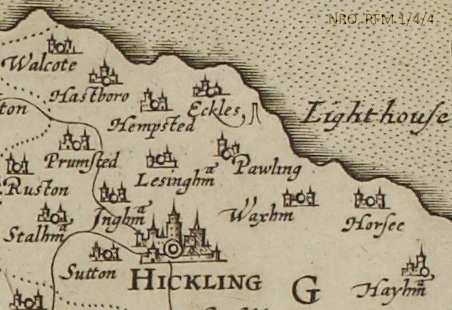David Stannard, local historian and Norfolk Archives and Heritage Development Foundation (NORAH) trustee has written this blog on an aspect of Norfolk’s coastal history, which is reflected in many of the talks on NORAH’s register of talks.
Legends of bells tolling beneath the waves surround many of the East coast churches which have succumbed to coast erosion over the ages. These include Shipden church lying off Cromer; St. Clements’s Church, Keswick offshore of Bacton; several of the churches lost at Dunwich in Suffolk; and the church of Eccles St. Mary-next-the-Sea between Happisburgh and Sea Palling.
Indeed, in this latter case Lieutenant-Commander RN A. Brooks, captain of HMS Boyne reported hearing a bell about 9.30 one morning in May 1930, followed a few minutes later by a second strike, which was also heard by his First Lieutenant. With both men unable to account for this strange occurrence and knowing of a similar old tale of Dunwich Church, the Commander, on arriving in Great Yarmouth, wrote to the editor of the Eastern Daily Press from aboard his ship asking for help in explaining the sound he had heard. 1
When abreast of Sea Palling, at about 9.30 a.m., I very plainly heard one stroke of a deep toned bell … have [any of your readers] heard any superstition of Eccles Church bells being heard at sea?
Lieutenant-Commander A. Brooks of HMS Boyne
Historical Facts Versus Legend
Sadly, the historical facts do not bear out this or any of the other tales of Eccles church bells tolling beneath the waves. The 1552 Inventory of Church Goods, a national survey of all English parish churches undertaken at the behest of Edward VI confirms that on 31 August 1552 Eccles St. Mary-next-the-Sea held two bells valued at £6. 2
Item ij [2] Belles weyenge by estimacion Eight hundredes [8 cwt] wherof the gret Belle weyeth vC [5 cwt] the ijde [2nd] Belle iij C xvlb [3cwt 15lb] – vjli [£6]
Inventory of church goods for the Hundred of Happing, 1552
However, within twenty years the church had been severely damaged by coast erosion and a decision was taken by the Diocese to dismantle the main body of the church and unite the parish of Eccles with neighbouring Hempstead.3 The steeple of the church, including in this respect the all-important belfry was not demolished, given its significant role as a seamark for aiding mariners to navigate at sea. The evidence for these actions comes from a copy of a deed of union contained in Tanner’s Index, a comprehensive set of administrative documents of the Diocese of Norwich, now held by Norfolk Record Office (NRO, DN/REG 31). The Deed of Union, dated 27 January 1571 (in new style dating), states that;
… the saide Church of Eccles by reason it is situate so near unto the Sea and for want of good Cliffes Walls seabanks and other defences the same Church is much decayed and not like long to stand And also the soil of the manner within that Parish is also spoyld by the rage of the Sea.
Deed of union of Eccles and Hempstead, dated 1571
In providing arrangements for the combining of the two parishes the Deed also includes a reference to what should happen to the demolished church where,
… the scyte lead Bells and Buildings of the said late parish Church of Eccles and the glebe lands of the same if any there be with their appurtenances whatsoever shall remain and be imployed to the use and behoofe of the aforesaid Thomas Brampton …
Deed of union of Eccles and Hempstead, dated 1571
As the Lord of the Manor of Eccles Thomas Brampton undoubtedly would have sold off the valuable bells, perhaps to be melted down, or they may still hang, unrecognized in another Norfolk belfry. It seems very unlikely that they would have been left at that time to disappear beneath the waves.
No Mention of the Valuable Bells
This may be confirmed by the probate inventory of Henry Hide, yeoman of Eccles, taken on 6 March 1593, and also held by Norfolk Record Office (NRO, DN/INV 9/314). Henry lived and farmed at Manor Farm, Eccles and he included the old church steeple as part of his property. When his ‘prisers’ [appraisers] made the inventory and valuation following Henry’s death they noted 40 codge swelles, or willow fish baskets; six drage rakes, probably used for gathering cockles or oysters. All the contents were valued at 18 shillings, but significantly no mention is made of any valuable bells.

In primis xxxx codge swelles, vj drage Rakes, iij new barrels with other implement[e]s thear – xviij s[hillings]. Probate inventory of Henry Hide, yeoman of Eccles, taken on 6 March 1593. NRO, DN/INV 9/314.

Map of circa 1602, which refers to the church tower of Eccles as a lighthouse. NRO, RFM 1/4/4.
The old steeple of Eccles St. Mary-next-the-Sea stood by the foreshore doing its duty as a humble store shed, sea-mark, warning beacon, lighthouse (it was marked on the circa 1602 map by William Smith, NRO, RFM 1/4/4) and Victorian tourist attraction for another 300 years until it too toppled into the teeth of a fierce Nor’Westerly gale on 23 January 1895. In all that time no known historical references refer to any bells still hanging in its belfry or lying at its skirts. 4
What did the Commander and his First Lieutenant Hear?
So what exactly was it that Lieutenant-Commander Brooks heard on that May morning in 1930? A further letter printed in the Eastern Daily Press on 23 May 1930 suggested that it was the tenor bell of Hickling church, with the sound carried by an offshore wind, which the seafarers had actually heard. The informant, who signed the letter ‘The Tenor’, claims that this heavy one-ton bell was rung twice that evening as the bell ringers left the tower, ‘and the time corresponded with the time that Commander Brooks heard the bell.’ 5 However, as observant readers will note, the good Commander said that he had heard the bell at 9.30 a.m. in the morning, not in the evening – so perhaps the jury is still out on this particular strange occurrence: but it surely couldn’t have been any bell of Eccles St. Mary’s church.
David Stannard, September 2018
- Brooks A. (1930) ‘Eccles church bells?’, Eastern Daily Press, 14 May
- Walters, H.B. (1952), ‘Inventories of Norfolk church goods (1552)’, Norfolk Archaeology, XXX, pp 370-8
- Stannard, D., (2014), ‘The timing of the destruction of Eccles juxta Mare’, Norfolk Archaeology, XLVI, pp 45-54
- Stannard, D., (2014), ‘The timing of the destruction of Eccles juxta Mare’, Norfolk Archaeology, XLVI, pp 45-54
- The Tenor (1930) ‘Eccles church bells’, Eastern Daily Press, 23 May














Reblogged this on Norfolk Tales & Myths.
LikeLike
Similar stories in Wales – the bells of Cantre’r Gwaelod, under Cardigan Bay
LikeLike
We (my parents and my sister) would spend summer days on Eccles beach in the late 1940s when we stayed at Sutton Staithe for our holidays (petrol ration restricted travel!) and I remember that there were quite big – but lying separately) chunks of. The church tower still lying close to where we got onto the beach from where we parked the car (no car park then!). Scary to realise that I am now so old that I remember a time only 50 years after the tower has still stood!
LikeLike
Wow John, that must have been an impressive site when you were young. It still amazes me how much the Norfolk coast changes over time. Certain areas I remember from when I was little have completely eroded away. Thanks for letting us know.
LikeLike
Many thanks for your recollections John, you probably parked close to my house which at that time was a dilapidated thatched barn. Of course the large lumps of masonry you saw seventy odd years ago are for the most part still lying on the beach…….but are now covered by several metres of beach sand. The last time I saw the ruins was just after the millenium.
David Stannard
LikeLike